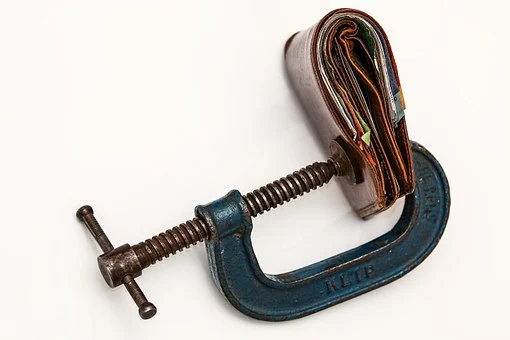So it has come to this. The money is done, the bills are there.

You don’t have/are looking for/just lost/are about to lose/just barely holding onto a job. Running away is not an option.
Most people’s standard of living and buying power have dropped a peg or two; mine a little more than yours maybe, but maybe not as much as the next man’s. One way or another, for many of us things look dim. What to do?
It’s either roll over and die or, pick yourself up, dust yourself off, get back in the race. That’s life, baby. But where to start? And how?
So it has come to this—the money is done, the bills are there. It’s either: Roll over and die – OR – Pick yourself up, dust yourself off, get back in the race.
Well, with a little planning, some patience, and lots of prayer, hope, and humble pie, you should be able to make things a little better. A major part of winning the battle is knowing that you are doing something positive—something that will yield some results, get you out of the hole that you seem to have fallen in.
So, let’s get started.
A Guide to Getting out of Debt
Determine the amounts you owe
Make a list of all the persons and companies that you owe, the amounts you owe, and how far behind you are with each payment. Put in everything as you must get a true picture of how bad things really are.
| Creditor | Total amt owed | Amt due now | How long overdue | Contact Name & tel # |
|---|---|---|---|---|
Look at the list carefully and try to place the items in order of importance. Decide which ones must be paid now or you will be facing the bailiff or the sidewalk, which ones can be put off for a little longer, which ones can do with a little payment to give you some ease, and so on.
Determine the funds that are available to you

Make a list of all your available sources of money and necessary expenses over the next 6–12 months. Be realistic.
Add up all your anticipated income for the month; think of every source including getting rid of some assets—you only need one TV and a little less cable now, right? You may have to consider working more hours at work or taking on part–time or gig work for a while. Be realistic.
Then, add all your expenses. Remember these expenses are the minimum you will have without starving. I thought of saying without suffering undue hardship, but ten I remembered that tolerance levels vary. How bare you make your expenses is dependent on how much financial trouble you are in based on the creditors list you just made. Again, be realistic.
If you owe everyone that you know, then don’t buy lunch, eat out of last night’s dinner. No fancy groceries, clothes or personal items. Put paid entertainment on hold—there are plenty of free options. This is no time to coddle yourself.
| Source of funds | Month 1 | Month 2 | Month 3 | Month 4 | Month 5 | Month 6 |
|---|---|---|---|---|---|---|
| Salary | ||||||
| Extra hours at work | ||||||
| Loan from Mama & Papa | ||||||
| Gig/Freelance Work | ||||||
| Other | ||||||
| Total Income/Funds |
| Expenses | Month 1 | Month 2 | Month 3 | Month 4 | Month 5 | Month 6 |
|---|---|---|---|---|---|---|
| Rent/Mortgage | ||||||
| Food | ||||||
| Utilities | ||||||
| Transportation | ||||||
| Personal items | ||||||
| Clothes | ||||||
| Medical | ||||||
| Insurance | ||||||
| School expenses | ||||||
| Savings | ||||||
| Other | ||||||
| Other | ||||||
| Total Expenses | ||||||
| Balance to pay debt |
Take away the Total Expenses from the Total Income to get the Balance Available to Pay Debt. That’s what you have for creditors. If, after you have upped your income and pared down your expenses, the balance covers your debt payments and even has space to increase the debt payments, this is excellent news for you.
However, if there is a shortfall, rest assured there is a solution, but you will have to tighten your belt for a while.
Allocate the available balance for debt
How should you use this balance to cover the debts that are due from the creditor list?
Usually, debts that affect your ability to earn an income are the most important. For instance, if you run a UBER service, your priority should be paying the car loan before the credit card bill or furniture payment. Next in importance is the roof over your head.
If there is a shortfall, work out a schedule that shares up the available amount over as many bills as possible.
At this point you don’t have to be paying all of any one payment. Most times banks and other finance companies want you to pay at least the interest due on the loan. What about skipping payments? Try to discretely find out how many missed payments you can have before each creditor starts to seriously harass you with demand letters and/or collectors.
The hardest part—Calling the creditors

After you have done your allocations and worked out the order of importance for the repayments, you want to approach the creditors, reassure them that you are here and not going anywhere, and work out something with them. It works.
Creditors, especially companies and banks, want to know that they can trust you. They want to get their money, not the car, fridge, or furniture. It might take a little longer than they expected, but if they can trust you will give them something as promised, they are sometimes willing to make some arrangements. You just have to be reasonable, open, and honest.
Do not hide from your creditors; that’s the worst thing you can do. Go to them before they come to you. But in order to go to them you have to have some idea of what you can do towards paying off the debt and when.
You will have to work up some major courage to call your creditors to arrange a time to see them to discuss the past due amounts. It may be hard and discouraging, but go to them humbly; call them before they call you. Most persons understand because, being in business, they have seen it before.
Working out a deal
The most important thing is to find the person who can actually arrange new terms for your repayment—this is never usually the first person you go to.

Your aim is to buy some time to get back on track. Usually they will want you to make new payments on time while slowly paying off the arrears. If you can do this fine but, if not, be frank and let them know that you have a little money but not all, so what you are looking for is a longer time to pay the full amount.
See if you can get some compromise on penalties and additional interest. Mention it, but don’t expect a positive answer the same day.
Also, find out if you can barter your skills for a part of the outstanding amount; a free employee—book-keeper/repairman/programmer/painter/whatever— may be worth a lot to your creditor. This might work with a landlord or mechanic.
Once you have arrived at some agreement, try to get it in writing even if you have to write it yourself. Do not make arrangements that you know from day one will be hard to manage, you will only be creating problems for yourself.
Stick to the new arrangements
This process may take several weeks of negotiating to get through all your creditors, but at least it should have bought you some relief. The last and most important thing in all of this is that you stick to the new arrangements. You need to build confidence with your creditors; they may not be 100% happy, but they won’t be out for blood either.
This payment plan process works even with the tax man. Just remember, don’t hide—go to them before they come to you.
So, unless things are really bad with your situation, it should help you to some extent. Otherwise, you would need to consult with a professional.
Other Articles of Interest









